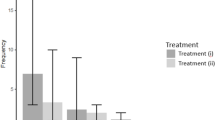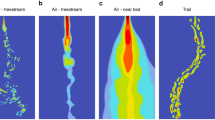Summary
The responses of the desert locust, Schistocerca gregaria, to air currents and light flashes were observed throughout the animals' development. Animals in the first stage respond by raising their legs, in later stages the “flight” position is assumed. In larvae exhibiting the “flight” position, electrical recordings demonstrate a tonic activity of the thick thoracic muscles. A pattern that can be said to be the typical flight pattern is first seen during the day following the imaginai ecdysis. During the three weeks after this ecdysis the wingbeat frequency increases exponentially from 10 to 20 Hz. Destruction of the wing stretch receptor organs in young adults causes immediate decreases in flight frequency like in older adults. A learning process is unlikely to be involved in flight pattern formation. Possible explanations of the frequency increase are discussed.
Similar content being viewed by others
References
Bentley, D. R.: Intracellular activity in cricket neurons during generation of song patterns. Z. vergl. Physiol. 62, 267–283 (1969).
— Hoy, R. R.: Postembryonic development of adult motor patterns in crickets: a neural analysis. Science 170, 1409–1411 (1970).
— Kutsch, W.: The neuromuscular mechanism of stridulation in crickets (Orthoptera: Gryllidae). J. exp. Biol. 45, 151–164 (1966).
Campbell, J. I.: The anatomy of the nervous system of the mesothorax of Locusta migratoria migratorioides R. & F. Proc. zool. Soc. (Lond.) 137, 403–432 (1961).
Dugard, J. J.: Directional change in flying locusts. J. Insect Physiol. 13, 1055–1063 (1967).
Elsner, N.: Die neuromuskulären Grundlagen des Werbeverhaltens der Roten Keulenheuschrecke Gomphocerippus rufus (L.). Z. vergl. Physiol. 60, 308–350 (1968).
Hunter-Jones, Ph.: Rearing and breeding locusts in the laboratory. London: Anti-Locust Research Centre 1966.
Kutsch, W., Huber, F.: Zentrale versus periphere Kontrolle des Gesanges von Grillen (Gryllus campestris). Z. vergl. Physiol. 67, 140–159 (1970).
—, Usherwood, P. N. R.: Studies of the innervation and electrical activity of flight muscles in the locust, Schistocerca gregaria. J. exp. Biol. 52, 299–312 (1970).
Möss, D.: Sinnesorgane im Bereich des Flügels der Feldgrille (Gryllus campestris L.) und ihre Bedeutung für die Kontrolle der Singbewegung und die Einstellung der Flügellage. Z. vergl. Physiol. 73, 53–83 (1971).
Novak, V. J. A.: Insect hormones, 3rd ed. London: Butler & Tanner Ltd. 1966.
Snodgrass, R. E.: The thoracic mechanism of a grasshopper and its antecedents. Smiths. Misc. Coll. 82, 1–111 (1929).
Svidersky, V. L.: Central mechanisms controlling the activity of locust flight muscles. J. Insect Physiol. 13, 899–911 (1967).
Usherwood, P. N. R., Machili, P.: Pharmacological properties of excitatory neuromuscular synapses in the locust. J. exp. Biol. 49, 341–361 (1968).
Waldron, I.: Mechanisms for the production of the motor pattern in flying locusts. J. exp. Biol. 47, 201–212 (1967a).
—: Neural mechanism by which controlling inputs influence motor output in the flying locust. J. exp. Biol. 47, 213–228 (1967b).
—: The mechanism of coupling of the locust flight oscillator to oscillatory inputs. Z. vergl. Physiol. 57, 331–347 (1968).
Wiesend, P.: Die postembryonale Entwicklung der Thoraxmuskulatur bei einigen Feldheuschrecken mit besonderer Berücksichtigung der Flugmuskeln. Z. Morph. u. Ökol. Tiere 46, 529–570 (1957).
Wilson, D. M.: The central nervous control of flight in locust. J. exp. Biol. 38, 471–490 (1961).
—: Relative refractoriness and patterned discharge of locust flight motor neurons. J. exp. Biol. 41, 191–205 (1964).
—: The nervous control of insect flight and related behaviour. In: Advances in insect physiology. (J. W. L. Beament, J. E. Treherne and V. B. Wigglesworth, eds.), vol. 5, p. 289–338. London and New York: Academic Press 1968.
Wilson, D. M.: Gettrup, E.: A stretch reflex controlling wingbeat frequency in grasshoppers. J. exp. Biol. 40, 171–185 (1963).
— Weis-Fogh, T.: Patterned activity of co-ordinated motor units, studied in flying locusts. J. exp. Biol. 39, 643–667 (1962).
Author information
Authors and Affiliations
Additional information
This work was supported in part by a Deutsche Forschungsgemeinschaft grant to Dr. W. Rathmayer.
I would like to thank Prof. Dr. F. Huber, Dr. W. Rathmayer, and Dr. L. Murdook for criticizing the manuscript, and Dr. L. Murdock for assistance in preparing the English text.
Rights and permissions
About this article
Cite this article
Kutsch, W. The development of the flight pattern in the desert locust, Schistocerca gregaria . Z. vergl. Physiologie 74, 156–168 (1971). https://doi.org/10.1007/BF00339930
Received:
Issue Date:
DOI: https://doi.org/10.1007/BF00339930




